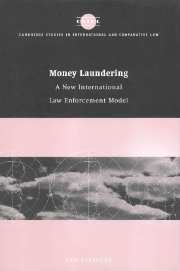Book contents
- Frontmatter
- Contents
- Preface
- Table of treaties and agreements
- List of abbreviations
- Part I New instruments in the fight against acquisitive crime: confiscation of proceeds from crime and criminalisation of money laundering
- 1 The background of the fight against money laundering
- 2 The confiscation
- 3 The fight against money laundering: genesis of a new crime
- Part II The prevention of money laundering
- Part III Jurisdiction over money laundering
- Part IV International co-operation in combating money laundering
- Epilogue
- Bibliography
- Index
- CAMBRIDGE STUDIES IN INTERNATIONAL AND COMPARATIVE LAW
3 - The fight against money laundering: genesis of a new crime
Published online by Cambridge University Press: 16 October 2009
- Frontmatter
- Contents
- Preface
- Table of treaties and agreements
- List of abbreviations
- Part I New instruments in the fight against acquisitive crime: confiscation of proceeds from crime and criminalisation of money laundering
- 1 The background of the fight against money laundering
- 2 The confiscation
- 3 The fight against money laundering: genesis of a new crime
- Part II The prevention of money laundering
- Part III Jurisdiction over money laundering
- Part IV International co-operation in combating money laundering
- Epilogue
- Bibliography
- Index
- CAMBRIDGE STUDIES IN INTERNATIONAL AND COMPARATIVE LAW
Summary
In this chapter, the contours of the phenomenon of money laundering will be outlined as will the reasons which have been advanced for fighting this phenomenon. In doing so, two jurisdictions, the United States of America and Switzerland, deserve special attention, because of their influence in the shaping of the international money laundering regime. Whereas the influence of US legislation is especially visible with respect to the incrimination of money laundering as laid down by international conventions, Swiss anti-money laundering measures have left their mark on the preventive legislation prescribed by international instruments. The international anti-money laundering regime which has subsequently developed, is characterised by a twin track approach in the fight against money laundering. The criminal strand of this money laundering regime will be discussed in this chapter while the preventive strategy will be analysed later.
Money laundering: the phenomenon and the reasons for fighting it
Concept of money laundering
The term ‘money laundering’ arose in the United States in the 1920s. It was apparently used by American police officers with reference to the ownership and use of launderettes by mafia groups. These groups showed an active interest in acquiring these launderettes, many of which were already owned by criminal groups, as they gave them a means of giving a legitimate appearance to money derived from criminal activities. These illicit proceeds were declared to be profits gained through launderettes and were thus ‘laundered’. The term ‘money laundering’ was apparently first used with a legal meaning in an American judgment of 1982 concerning the confiscation of laundered Columbian drug proceeds.
Before attempting to give a juridical definition of money laundering, it is necessary to investigate the phenomenon of money laundering itself.
- Type
- Chapter
- Information
- Money LaunderingA New International Law Enforcement Model, pp. 82 - 130Publisher: Cambridge University PressPrint publication year: 2000

